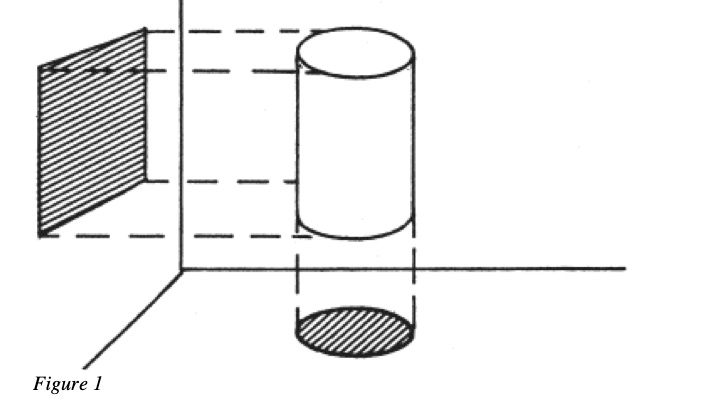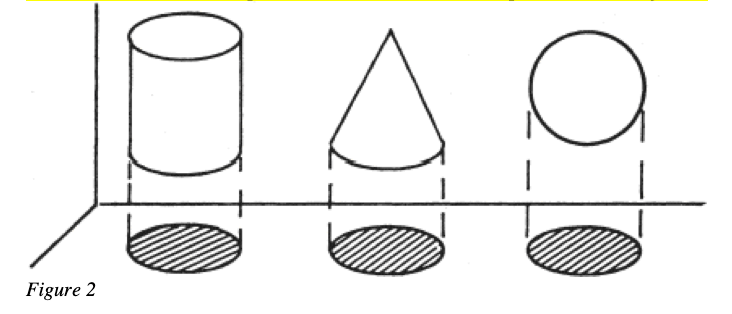Laws of Dimensional Ontology
First Law of Dimensional Ontology
One and the same phenomenon projected out of its own dimension into different dimensions lower than its own is depicted in such a way that the individual pictures contradict one another.
Example
Imagine a cylinder, say, a cup. Projected out of its three-dimensional space onto a horizontal and vertical two-dimensional planes, it yields in the first case a circle and in the second one a rectangle. These pictures contradict one another.
What is even more important, the cup is an open vessel in contrast to the circle and the rectangle which are closed figures.

Second Law of Dimensional Ontology
Different phenomena projected out of their own dimension into one dimension lower than their own are depicted in such a manner that the pictures are ambiguous.
Example
Imagine a cylinder, a cone, and a sphere. The shadows they cast upon the horizontal plane depict them as three circles which are interchangeable. We cannot infer from a shadow what casts it, what is above it, whether a cylinder, a cone, or a sphere.

Implication of the Laws
According to the First law of dimensional ontology, the projection of a phenomenon into a different lower dimensions results in inconsistencies, and according to the second law of dimensional ontology, the project of different phenomena into a lower dimension results in isomorphies.
Once we have projected man into the biological and psychological dimensions we also obtain contradictory results. For in the one case a biological organism is the result; in the other one, a psychological mechanism. But, however the bodily and mental aspects of human existence might contradict one another, seen in the light of dimensional anthropology this contradiction no longer contradicts the oneness of a man.
The openness of a cup necessarily disappears in the horizontal and vertical dimensions. Well, man, too, projected into a dimension lower than his own seems to be a closed system, be it a physiological reflexes or psychological reactions and responses to stimuli.
The primary thrust of Frankl’s argument was that human beings exist in the “noological” (spiritual) dimension that sits higher than the psychological and biological. The moment we reduce ourselves to lower dimensions, it causes inconsistencies, contradiction, and confusion.
Science cannot cope with reality in its multidimensionality, but must deal with reality as if reality were unidimensional. However, a scientist should remain aware of what he does, if for no other reason than to avoid the pitfalls of reductionism.
What is dangerous is the attempt of a man who is an expert, say, in the field of biology, to understand and explain human beings exclusively in terms of biology. The same is true of psychology and sociology as well. …
What we have to deplore, I would say, is not that scientists are specializing but that the specialists are generalizing. … those who cannot resist the temptation to make overgeneralized statements on the grounds of limited findings.
source: Viktor Frankl’s Laws of Dimensional Ontology and The Fallacy of the Dominant Dimension